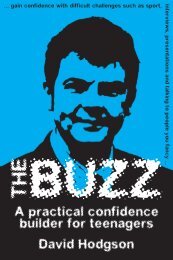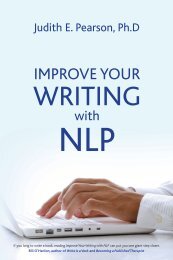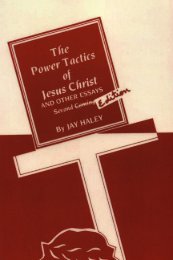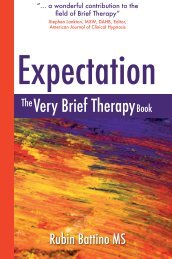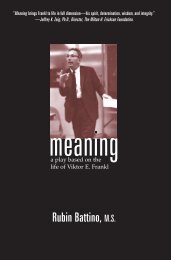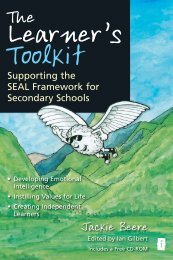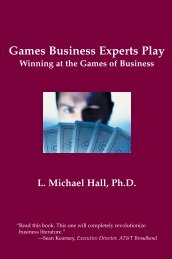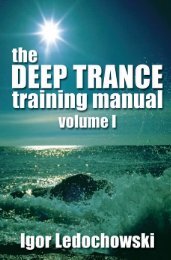Plenary
Look Inside - Crown House Publishing.
Look Inside - Crown House Publishing.
- No tags were found...
You also want an ePaper? Increase the reach of your titles
YUMPU automatically turns print PDFs into web optimized ePapers that Google loves.
How to teachHere endeth the lesson …the book of<strong>Plenary</strong>Phil Beadle
AcknowledgementsIt is now long overdue that I thank Caroline Lenton who, despite theevidence, is still of the belief that a book on education can be comicwithout necessarily making the writer a clown, and who sees somevalue in me. I’d also like to thank Rosalie Williams, for whom nothingis ever too much trouble. And I’d like to thank Bev Randell, who knowsa silk purse when she sees one.Thanks are also due to David Didau for casting an eye, and for providingcompetition worthy of the name.
ContentsIntroduction . . . . . . . . . . . . . . . . . . . . . . . . . . . . . . . . . . . . . . . . . . . . . . . . . . . . . 1Part 1 An Overview of the <strong>Plenary</strong> . . . . . . . . . . . . . . . . . . . . . . . . . . . . . . . . 5Part 2 Analogue Plenaries . . . . . . . . . . . . . . . . . . . . . . . . . . . . . . . . . . . . . . 371 Don’t Share the Objectives Until the End . . . . . . . . . . . . . 392 Start with a Gag . . . . . . . . . . . . . . . . . . . . . . . . . . . . . . . . . . 403 A Pyramid of <strong>Plenary</strong> . . . . . . . . . . . . . . . . . . . . . . . . . . . . . . 424 Show Me the Money . . . . . . . . . . . . . . . . . . . . . . . . . . . . . . . 445 Pick On Two Students . . . . . . . . . . . . . . . . . . . . . . . . . . . . . . 456 Extended Abstraction . . . . . . . . . . . . . . . . . . . . . . . . . . . . . . 467 What is the Exact Opposite of What You Have Learntin This Lesson? . . . . . . . . . . . . . . . . . . . . . . . . . . . . . . . . . . . 508 The Frozen Picture . . . . . . . . . . . . . . . . . . . . . . . . . . . . . . . . . 529 Mime the Learning . . . . . . . . . . . . . . . . . . . . . . . . . . . . . . . . 5410 Key Word Storytelling . . . . . . . . . . . . . . . . . . . . . . . . . . . . . 5511 Key Word Definition Matching . . . . . . . . . . . . . . . . . . . . . . 5712 Pelmanism . . . . . . . . . . . . . . . . . . . . . . . . . . . . . . . . . . . . . . . 5913 Do It Yourself Will Ya? . . . . . . . . . . . . . . . . . . . . . . . . . . . . . . 6014 Quizzes . . . . . . . . . . . . . . . . . . . . . . . . . . . . . . . . . . . . . . . . . . 6115 Taboo . . . . . . . . . . . . . . . . . . . . . . . . . . . . . . . . . . . . . . . . . . 6216 Drinking Games . . . . . . . . . . . . . . . . . . . . . . . . . . . . . . . . . . . 6317 Spot the Deliberate Mistake . . . . . . . . . . . . . . . . . . . . . . . . 6518 Re-ordering or Re-sequencing a Text . . . . . . . . . . . . . . . . . 67i
The Book of PLenaryBy the end of this chapter (I hope) you will be able to:1 Identify and articulate what your students will get out of a wellconductedplenary.2 Regurgitate what Ofsted have to say about plenaries and, in particular,where they think we are going wrong.3 Clarify what you think about certain aspects of planning a plenary(relating the plenary to the objectives, starting with a plenary, miniplenaries) – good or bad.4 Relate to the problems that your students might have with plenaries,and have strategies to overcome these.5 Use the plenary as an effective part of your already well-developedAssessment for Learning (AfL) strategies.6 Relate your understanding of the plenary to what Professor John Hattiehas to say about the end of the lesson.7 Be marginally better read on the subject of domain specificity thanyour colleagues and, perhaps, have an opinion as to whether domaingeneraland domain-specific ideas of cognition are mutually exclusiveor not. (This may not make any sense to you now. And it may notmake any sense to you later on.)And that’s just Part 1.Organisationally, the book has been constructed (if that is not too baroquea term for such a short tome) with in-built differentiation at its core. Themajority of readers will want a brief overview of how one might most profitablyconduct a plenary (this is in Part 1: An Overview of the <strong>Plenary</strong>), and afew decent ideas on easy strategies to use that may have some benefit fortheir students (this is in Part 2: Analogue Plenaries). If your needs have been2
Introductionfulfilled by these two sections, I’d advise you not to bother going any further,as the second half of this book is heavy going if you are not of a mind to tryand understand some nearly difficult stuff.For the gifted and talented reader(s) – teaching spods, bloggers, CPD coordinatorsand assistant and deputy heads in charge of teaching and learning– there is an acknowledgement that writing a book, however short, on ametacognitive activity and not brushing on metacognition would be an actof professional negligence (it is therefore covered, albeit clumsily, in Part3: Metacognition for Beginners). Where the book begins to fly a little, andwhere it is, I feel, potentially useful is in Part 4: Digital Plenaries. Many ofthese ideas will appear, and indeed are, simple. I’d say that this is not necessarilya reason to write them off, as it is rarely simplicity that is the enemyin teaching. It is in this section that I have attempted to translate my readingof the research into strategies that, plausibly, might have a substantialimpact on the students’ learning in your specific domain. 33 If you understand that this is a joke (albeit an unfunny one), then you should definitely readParts 3 and 4.3
Part 1An Overview ofthe <strong>Plenary</strong>Firstly, let us acknowledge that the plenary is not in any way sexy; the worditself is unpleasingly under-erotic, seeming to bring to mind some unpalatableinfection of the penis: pleeenary.‘What’s wrong with it, Doctor?’‘Aside from the size? Well, sadly, I must inform you that you have a nastylittle dose of non-specific plenary.’And that, dear colleagues, may well be one of the reasons – go on, be honest– that you (or I) do not always do them. In fact, you can pretty wellguarantee that if you get working parties together in schools to examine theassorted parts of our professional practice, and give various groups their pickof what they are going to look at, you’ll find, at the end, that the plenaryis sat parked, about as popular as a ginger stepson, as the last forlorn car inthe garage.There is also the added weirdness that the word ‘plenary’, to a teacher in theUnited Kingdom, signifies something that it doesn’t mean to anyone else insane society or the wider world. To people who inhabit workplaces devoid ofstaffrooms, a plenary is the compulsory bit of a conference when delegatesall come back from the ‘break-out’ rooms or the workshops into the mainhall. It is during a ‘plenary’ that you will most likely have to sit through atedious ‘keynote’ speech from an academic or bore (or both).5
An Overview of the <strong>Plenary</strong>What Will Your Students Get Out ofa Good <strong>Plenary</strong>?‘What’s the point of all this stopping ten minutes before the end of the lessonand then doing some weirdness, Sir, just when we’ve understood whatyou wanted us to do in the main task?’ Could Denzil be right here? What’sthe point? The lesson is going swimmingly. Why stop it, and manage yetanother oh-so-bloody-knackering-and-difficult transition, just at the exactpart of the lesson at which you are most tired?Alternatively, what’s the point? The lesson has been a disaster from start tofinish; the kids have been fractious all along. 4 Why stop it, and manage yetanother oh-so-difficult transition, just at the point when you are most tired?Look at it through another similarly phrased prism: what’s the point? What’sthe point of going to all that trouble planning an interesting sequence ofactivities and inputs when they don’t remember anything from the lesson?You may just as well have got them to do some lovely colouring-in(!). What’s the point of going all the way to 85% and just throwing the last15% in the waste-bin? What’s the point of having thought really hard aboutthe content of the lesson and then copped out just at the bit where theyactually cement the information in their heads? What’s the point of paintingsomething if you aren’t going to varnish it? The colour will all wash off comethe first passing shower.Without the plenary you are arguably just going through the motions andpassing time. It was a nice enough experience, but they don’t remember it.And the point of lessons is that they are remembered, otherwise they arenot lessons learnt.4 ‘Sir looks a bit grey today. Let’s mess about!’7
The Book of PLenaryThe existence of the plenary is to help the students remember what theyhave learnt in the lesson. If you don’t, erm, do one it is vastly more than likelythat they will have substantially less recall of the learning. If we shift thefocus to Professor John Hattie, he’s quite categorical:The lesson does not end when the bell goes. It ends when teachersinterpret the evidence of their impact on student(s) during the lessonsrelative to their intended learning outcomes and initial criteriaof success – that is when teachers review the learning throughthe eyes of their students. 5There are a few elements to this observation that benefit from a briefunpacking. Firstly, Hattie here gives implicit, yet emphatic, confirmation thatsome checking of the learning must take place; the end of the lesson seemsa quite reasonable place at which to do this. Secondly, he is explicit thatwe’ve somehow to reframe the way that we look at the learning experienceso that it is the opinion(s) of the students that lead us to review and alterwhat we are doing in lessons. (There is a pro forma that will be of help if youwant to take Hattie’s observation as being the gospel here, in the first of thedigital plenaries in Part 4: Homework’s Holy Grail.)In performing a task that is specifically related to the learning (and to theobjectives), students may come to new realisations and make new connectionsthey hadn’t made earlier on in the lesson. Consequently, a decentplenary will extend and broaden their knowledge of the concept or skillbeing taught.However, there is also a quite interesting and entirely reasonable argumentthat the best thing students will get out of a decent plenary is an understandingof what they do not know. As Darren Mead, whose Pedagogical5 John Hattie, Visible Learning for Teachers: Maximising Impact on Learning (Abingdon:Routledge, 2012), 145.8
An Overview of the <strong>Plenary</strong>Purposes blog reveals him to be perhaps the most intellectually engagedof all British teachers, states: ‘Becoming less confident in their knowledge isjust as valid a response, as they could either be unlearning a misconception,which is a difficult process or be questioning why they believe somethingrather just accepting something is right.’ 6Mead is bang on here, and his assertion tallies nicely with Hattie’s thoughts(above) about the same: specifically, that what we should be looking for isfor the students to be able to identify what they don’t understand and toimplement (practised) strategies to obtain that knowledge; to fill that gap.What Does Mr LessonInspector Say?Here’s what those who are employed to take out kitchen scales from shinybriefcases and comment on the weight of a thing had to say about our useof plenaries some considerable time ago. 7 Ofsted’s evaluation of the KeyStage 3 pilot in English and maths commented that teachers are good atstanding at the front of classrooms reading lesson objectives to our studentsfrom a PowerPoint, and that we’re also good at giving the students a pointlessactivity that takes ten minutes at the beginning of a lesson. They areless happy, however, with the plenary; and pointedly use the language ‘lackof well managed’ and ‘weakness’ in a rather unpleasantly pointed manner:6 Darren Mead, ‘Metacognitive Wrappers’ (2010). Available at http://pedagogicalpurposes.blogspot.co.uk/2010/11/metacognitive-wrappers.html (accessed 22 May 2013).7 And I mean, ages. There is very little analytical thought that has been published on the plenary,which is why this book is already the seminal text on it: no one else could be botheredto write one.9
An Overview of the <strong>Plenary</strong>If we reverse the box tickers’ conclusions as to why plenaries are poor, wecan state fairly conclusively what the fundamentals of a good one would be.1 It has to be plannedYou can’t just go into a lesson with any sense that you will just pullsomething out of the bottomless well of your imagination. With allthe will in the world, if you think you can just magic one up fromnowhere, you are kidding yourself and in forty minutes’ time you willbe asking them, ‘So what did you learn in this lesson?’ You’ll go intothe lesson intent on finding a little moment in which you can rustleup an idea, but you’ll get caught up in something else. Keith willrequire some tissues for his bottom lip. Everyone will want your attention.You will forget.2 You have to leave sufficient time for themKey to this is not to see plenaries as the end of the lesson, but as anintrinsic part of it. What tends to happen is that teachers get caughtup in the main lesson activity, as they (not unreasonably) give the‘body’ of the lesson due preference. This has its head on the wrongway round. It is the mindset of seeing the plenary as a tacked-on irrelevancethat makes the majority of them ineffective; they should beseen not as a tacked-on imposition, but as a vital part of the lesson’sfunction. There’s no point whatsoever in teaching good lessons thatbring in sparkling and vital new knowledge if the kids have forgottenthat information before they have even got as far as the classroomdoor. So, fundamental to running a decent plenary is to give it adecent fist of time. Ten minutes, not two. 12 This will also ensure that,12 There is a school of thought, however, that thinks the plenary can be of variable length:two minutes on a Monday, twenty on a Tuesday, thirteen-and-a-half on a Friday. It’s notunreasonable. However, the key here is that you plan for it, and that in planning you leave areasonable amount of time for a planned activity.11
ediTed by Phil beadleIf you buy only one book on metacognitivestrategies for the last ten minutes of thelesson this year, make it this one!The Book of <strong>Plenary</strong> is the first in Phil Beadle’s ‘How to Teach’ series, in which he examines– in detail – every aspect of the modern classroom. The first half of this volume givesinterested teachers a series of easy-to-set-up activities that make plenaries engaging andworthwhile.The second half is a detailed and almost serious examination of metacognition in theclassroom. It seeks to give teachers the stimulus to prepare and research plenaries fullyso that they actively seek to develop the metacognitive experience, knowledge and selfregulation of students. Distanced from glib ‘learn-to-learn’ programmes, this book engageswith available research about metacognition and presents its relevance to the classroomin a lively, although sometimes childish, manner.@philbeadlePhil Beadle is an English teacher and a former National Teaching Awards United KingdomSecondary Teacher of the Year. He has also won two Royal Television Society Awards - forChannel 4’s The Unteachables and Can’t Read Can’t Write. He is the editor/author of the‘How to Teach’ series, a series of books which cover every element of classroom practicein a highly practical, but wildly irreverent, manner. www.philbeadle.comhow to teachhow To TeachSemantics, Stanzas and Semi Colons …Literacyacross the curriculumAnyone can feed skittles to sharks …PrimaryMathsHow to teachISBN: 9781845903930PhiL BeadLeLiteracy acrossthe curriculumISBN: 9781781351284Nick Tiley-NunnPrimary MathsNick Tiley-NunnISBN: 9781781351352www.independentthinkingpress.comISBN 978-178135053-9US $19.955 1 9 9 59 781 781 35 05 39Education Teaching Skills



